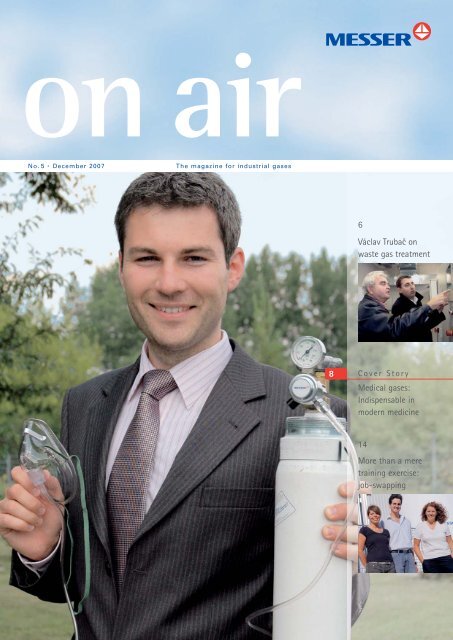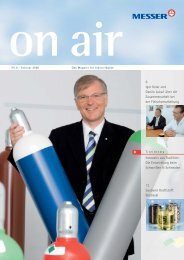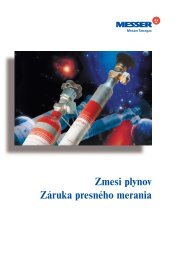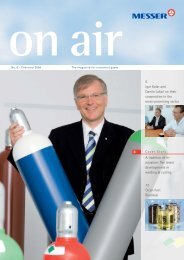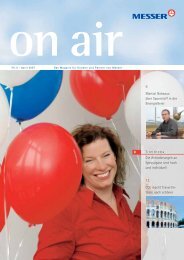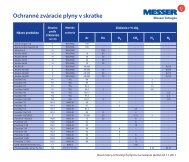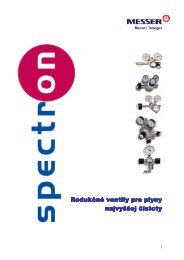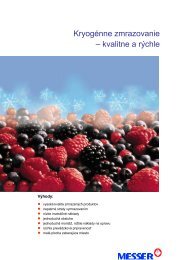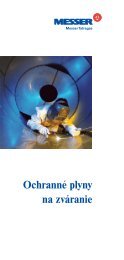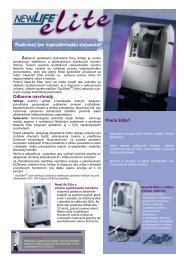Create successful ePaper yourself
Turn your PDF publications into a flip-book with our unique Google optimized e-Paper software.
on air<br />
No. 5 · <strong>December</strong> <strong>2007</strong><br />
The magazine for industrial gases<br />
6<br />
Václav Trubač on<br />
waste gas treatment<br />
8<br />
Cover Story<br />
Medical gases:<br />
Indispensable in<br />
modern medicine<br />
14<br />
More than a mere<br />
training exercise:<br />
job-swapping
2 : Contents<br />
Cover Story : 8–11<br />
More than just the air that<br />
you breath – medical gases<br />
Gases are used in a variety of applications in modern-day medicine.<br />
<strong>Messer</strong> not only supplies the necessary medical gases, but also the requisite<br />
hardware.<br />
Wojciech Pastuszczyn, a member of the Applications Technology<br />
sales force at <strong>Messer</strong> Poland, presenting a mobile medical oxygen<br />
cylinder, together with the accompanying mask.<br />
Editorial : 3<br />
News : 4–5<br />
Interview : 6–7<br />
Removing CFCs from the air:<br />
state-of-the-art technology<br />
Václav Trubač, Plant Director at the<br />
Slovakian company Elektro Recycling<br />
on a waste gas treatment process.<br />
<strong>Messer</strong> World : 12–14<br />
Cost-efficient heat treatment –<br />
metallurgically beneficial and flexible<br />
E<br />
The patented Endolin process –<br />
an economical alternative.<br />
Using carbonic acid to<br />
neutralize waste water<br />
The power plant in the Estonian town of<br />
Narva is exploiting the benefits of neutralizing<br />
waste water with CO 2 .<br />
More than a mere training exercise<br />
An international job-swapping scheme<br />
promotes communication, common values<br />
and better cooperation.<br />
The DuoCondex plant at Elektro<br />
Recycling in Slovakia<br />
The Narva power plant in Estonia<br />
Imprint<br />
Published by:<br />
<strong>Messer</strong> <strong>Group</strong> GmbH<br />
Corporate Communications<br />
Otto-Volger-Strasse 3c<br />
D-65843 Sulzbach<br />
Germany<br />
Editorial Team:<br />
Diana Buss – Editor-in-chief<br />
Tel.: +49 6196 7760-361<br />
diana.buss@messergroup.com<br />
Benjamin Auweiler, Thomas<br />
Böckler, Marc Dierckx,<br />
Christoph Erdmann, Michael<br />
Holy, Anita Kötél, Monika<br />
Lammertz, Joachim Rohovec,<br />
Marlen Schäfer<br />
Concept and Realization:<br />
Maenken Kommunikation GmbH<br />
Von-der-Wettern-Strasse 25<br />
D–51149 Cologne<br />
Germany<br />
Translation:<br />
Context GmbH<br />
Elisenstrasse 4-10<br />
D-50667 Cologne<br />
Germany<br />
Many thanks to<br />
all the contributors!<br />
Go to www.messergroup.com<br />
for comprehensive information<br />
about on air, as well as the<br />
contact details of the editorial<br />
team.<br />
Job-swapping scheme in Hungary<br />
on air is published four times<br />
a year in German, English and<br />
Hungarian.<br />
on air 05 · <strong>2007</strong>
Editorial : 3<br />
The editorial team<br />
Editor-in-chief:<br />
Diana<br />
Buss<br />
Corporate Office:<br />
Benjamin<br />
Auweiler<br />
Marlen<br />
Schäfer<br />
Application Technology:<br />
Thomas<br />
Böckler<br />
Monika<br />
Lammertz<br />
Production & Engineering:<br />
Dr. Christoph<br />
Erdmann<br />
West Europe region:<br />
Joachim<br />
Rohovec<br />
Dear Readers,<br />
When used in the treatment of sick<br />
patients, nitrogen and oxygen gain new<br />
status as medical products or even pharmaceuticals.<br />
Indeed artificial respiration<br />
using pure oxygen can save lives. And<br />
other gases have also long since been<br />
routinely deployed in general medical<br />
healthcare.<br />
Yet other technologies are also being<br />
pressed into service to the lasting benefit<br />
of both man and beast, namely to protect<br />
our planet’s water, soil and the atmosphere<br />
from contamination and irreparable degradation.<br />
Stefan <strong>Messer</strong><br />
Each day in Europe almost as many disused fridges land on the scrap heap<br />
as are purchased – a trend, which is spawning veritable mountains of refrigerators<br />
across the sites of specialist recycling companies. The recycling of CFC-contaminated<br />
refrigerators requires technologies capable of capturing the climate-damaging<br />
greenhouse gases emitted in the crushing process. Using cryogenic nitrogen the<br />
waste gases emitted from the crushing plants can be effectively purified of solvents<br />
and freons, separated from the air and captured. The technological capacity to<br />
recycle refrigerators in compliance with EU clean air directives has also raised a<br />
further exciting prospect: namely, recovering valuable raw materials, such as<br />
aluminium and copper.<br />
Environmental protection is also high on the agenda at the Estonian oil<br />
shale-fired power station Narva. To regulate the pH value of its waste water prior<br />
to discharge into the river separating Estonia and Russia, the introduction of carbonic<br />
acid renders the use of hydrochloric acid superfluous.<br />
Marc<br />
Dierckx<br />
Central Europe region:<br />
I hope you all enjoy reading this latest issue of on air!<br />
Best regards,<br />
Michael<br />
Holy<br />
Southeastern Europe region:<br />
Stefan <strong>Messer</strong><br />
Anita<br />
Kötél<br />
on air 05 · <strong>2007</strong>
4 : News<br />
DaimlerChrysler: The green and sound<br />
proofed way to clean engine components<br />
Using the Ascojet 2001RS dry-ice blaster, the<br />
complex task of manually removing silicon<br />
Fresh products require a<br />
continuous refrigeration chain.<br />
Dry-ice bags - a vital<br />
link in the refrigeration chain<br />
Freshness and protection are accorded the highest<br />
priority in the transportation of perishable goods.<br />
Not least because a set of legally stipulated temperatures<br />
must be observed across the entire refrigeration<br />
chain for fresh products. The Slovenian company<br />
Mercator uses dry-ice bags to ensure the energy-independent<br />
refrigeration of its goods during transport.<br />
Available in various capacities ranging from 500 g to<br />
4 kg, the bags are expertly, safely and cost-efficiently<br />
filled with dry-ice snow in a Cryo2pack5 facility.<br />
Monika Lammertz, <strong>Messer</strong> <strong>Group</strong><br />
residues from engine parts can now be undertaken<br />
in a highly efficient, yet environmentally<br />
friendly manner. Asco Carbon Dioxide has<br />
supplied DaimlerChrysler’s engine assembly<br />
plant in Bad Cannstatt with a complete dryice<br />
cleaning solution equipped with a soundinsulating<br />
cabinet.<br />
This task can now be integrated into the<br />
work processes of the assembly hall – free of<br />
any noise pollution. Further operational safety<br />
is also ensured by an integrated, externally<br />
controlled CO 2 extraction unit.<br />
Marco Pellegrino, Asco Carbon Dioxide<br />
A complete one-stop solution:<br />
soundproof dry-ice cleaning.<br />
On-site efficiency<br />
For customers requiring a continual supply of gas, on-site plants generating<br />
oxygen, nitrogen and argon offer clear benefits. Besides providing maximum<br />
supply security and energy efficiency, they also eliminate the costs of road<br />
transport and the associated noise pollution and other adverse environmental<br />
impacts. <strong>Messer</strong> is currently constructing air-separator units at the steel producers<br />
ArcelorMittal in Bosnia-Herzegovina, TMK in Romania and at the Switzerland-based<br />
Lonza AG. In Spain a further air separator is being commissioned<br />
to boost capacity of the pipeline network at the Tarrogona chemicals plant.<br />
In addition, <strong>Messer</strong> is also building air separators in France and Poland<br />
as part of a joint venture.<br />
Dr. Christoph Erdmann, <strong>Messer</strong> <strong>Group</strong><br />
Reaping the benefits of<br />
an on-site air separator –<br />
the computer model of a<br />
new facility in Poland.<br />
<strong>Messer</strong> supporting children’s charity<br />
“Games Without Frontiers” in Serbia.<br />
Making kids happy<br />
Humanitarian aid organizations are reliant upon outside<br />
support, as demonstrated by the “Small Big<br />
People” day in Serbia. Staged at Ušće Castle in June by<br />
the relief organization “Games Without Frontiers”, the<br />
event was designed to give deprived youngsters from<br />
the children’s home in Kulina an exciting and memorable<br />
day. <strong>Messer</strong> Serbia was actively involved in the<br />
preparations and also donated T-shirts and helped to<br />
launch the helium-filled balloons.<br />
Marija Vuković, <strong>Messer</strong> Tehnogas<br />
on air 05 · <strong>2007</strong>
News : 5<br />
Nitrogen for mobile telephones<br />
The company OLHO-Technik uses dry ice to remove<br />
residues from its plastic parts.<br />
Using snow to clean plastic<br />
Based in the Czech Republic, the company OLHO-<br />
Technik Czech is profiting from a new snow-blaster<br />
which uses carbon dioxide to clean plastic components<br />
for the auto industry. Applied to the component’s surface<br />
using compressed air, the snow’s fine particles<br />
remove the residues created in the manufacturing process<br />
such as mould release agents and fats. In contrast<br />
to conventional water-based cleaning methods, this<br />
new process dispenses with costly drying and thus<br />
saves time. <strong>Messer</strong> Czech Republic acquired the new<br />
customer on the strength of a recommendation from<br />
the lacquer plant producer Venjakob and the snow-gun<br />
manufacturer mycon.<br />
Due to the unabated trend towards the miniaturization of components and<br />
circuit boards, Elcoteq Tallinn, a producer of mobile phones, wireless modules,<br />
cordless telephones and equipment for communications networks, requires<br />
substantial quantities of nitrogen for soldering in its assembly process. This is<br />
supplied to the Estonia-based company by <strong>Messer</strong>. A subsidiary of Elcoteq SE,<br />
Europe’s largest electronics contract manufacturer for communications technology,<br />
Elcoteq Tallinn now ranks among <strong>Messer</strong>’s leading electronics customers<br />
in the region.<br />
Natalia Vinogradova, Elme <strong>Messer</strong> Gaas<br />
Elcoteq uses<br />
nitrogen for soldering<br />
miniaturized<br />
components,<br />
such as circuit<br />
boards for mobile<br />
telephones as shown.<br />
Josef Filip, <strong>Messer</strong> Technogas<br />
Pure water from<br />
pure oxygen<br />
The introduction of pure oxygen into their modern<br />
industrial waste water treatment plants has been as-<br />
Osisting the chemicals company Spolchemie and the<br />
2<br />
cellulose producer Biocel to effectively treat their effluent.<br />
Based in the Czech Republic, both companies<br />
were faced with an ever-rising pollution load. The<br />
introduction of higher quantities of oxygen into the<br />
biological purification stage has been achieved with<br />
deployment of <strong>Messer</strong>’s state-of-the-art injector<br />
technology, which ensures simultaneous admission<br />
of oxygen and agitation of the waste water.<br />
Dr. Ivo Vágner, <strong>Messer</strong> Technogas<br />
State-of-the-art technology ensures the admission<br />
of oxygen and the simultaneous agitation of effluent<br />
in industrial treatment plants.<br />
Innovative<br />
ideas secure a<br />
leading edge<br />
The rise in the export of<br />
tropical fruits and vegetables<br />
from Peru has<br />
prompted a marked<br />
increase in the demand<br />
Liquid carbon dioxide – evaporated<br />
directly in containers –<br />
for nitrogen and CO 2 for<br />
inerting and refrigerating<br />
goods during ship-<br />
cools fruit at twice the speed.<br />
ment. By switching from gaseous to liquid carbon<br />
dioxide, the fruit can be cooled at twice the speed<br />
in the refrigerated containers. This new method of<br />
directly evaporating CO 2 has also won over the company<br />
Maersk Peru, a subsidiary of one of the world’s<br />
largest container shipping companies.<br />
Juan Bedoya, <strong>Messer</strong> Gases del Peru<br />
on air 05 · <strong>2007</strong>
6 : Interview<br />
Removing CFCs from the air: state<br />
Customers apply the DuoCondex process to treat waste gases or to<br />
recover solvents from waste gases. The Slovakian company Elektro Recycling<br />
is now the first user to deploy this technology to purify the gases emitted by<br />
its refrigerator recycling plant. on air spoke to Plant Director Václav Trubač<br />
about his firm’s cooperation with <strong>Messer</strong>.<br />
YOUR CONTACT PER-<br />
Dr. Friedhelm Herzog<br />
Head of Technology Management<br />
Industry<br />
<strong>Messer</strong> <strong>Group</strong> GmbH<br />
Tel.: +49 (0) 2151 7811-225<br />
friedhelm.herzog@messergroup.com<br />
Languages:<br />
on air: You are the first customer in Slovakia to apply<br />
<strong>Messer</strong>’s waste gas treatment process. Are you collaborating<br />
on any other joint projects?<br />
Václav Trubač: To date we have been recycling some<br />
75,000 fridges a year and the numbers are increasing<br />
steadily. So, to meet this demand, we have been<br />
cooperating with a team of <strong>Messer</strong> specialists to<br />
examine the feasibility of doubling the plant’s operating<br />
time from its original 8 to 16 hours, and even<br />
switching to continuous operation. Currently, the<br />
Elektro Recycling management team is considering<br />
expanding operating times in individual situations to<br />
boost processing capacity if required.<br />
on air: Why did you decide to collaborate with <strong>Messer</strong>?<br />
Václav Trubač: I was already familiar with <strong>Messer</strong><br />
from my previous employer – where our experience<br />
had been very positive. There we applied nitrogen<br />
in bio-technological production, particularly for<br />
isolating penicillin.<br />
At Elektro Recycling we were convinced by the<br />
DuoCondex’s ability to efficiently remove chlorofluorocarbons<br />
(CFCs) from the waste gas emitted by the<br />
refrigerator crushing plant. We purchase liquid nitrogen<br />
and gaseous oxygen.<br />
on air: Do you require much expertise on industrial<br />
gases to deploy these gases?<br />
Václav Trubač: Taking delivery of liquid nitrogen requires<br />
only minimal supervision on our part. The automatic<br />
telemetry monitoring system of the 30 cm 3 container<br />
ensures that <strong>Messer</strong> replenishes our supply of<br />
nitrogen as soon as levels in the container fall below<br />
a certain limit. We use the oxygen to dispose of mercury-containing<br />
lamps – at which we are specialists.<br />
For us the gases are an indispensable means to an end.<br />
Their application<br />
Plant manager Václav<br />
Trubač, (left) explaining to<br />
Matej Pokrievka, Sales Manager<br />
Chemicals/Environment at<br />
<strong>Messer</strong> Tatragas, Slovakia,<br />
the details of Elektro<br />
Recycling’s plant.<br />
on air 05 · <strong>2007</strong>
Interview : 7<br />
-of-the-art technology<br />
Václav Trubač (left) and Matej<br />
Pokrievka immersed in conversation:<br />
“The input and technical advice<br />
from <strong>Messer</strong>’s staff have been<br />
of very high quality.”<br />
is as routine as using water or electricity and does<br />
not require us to have any special expertise.<br />
on air: How would you describe the cooperation<br />
between your company and <strong>Messer</strong> and its staff?<br />
Václav Trubač: The input and technical advice from<br />
<strong>Messer</strong>’s staff have been of the highest quality and<br />
they have always responded promptly to<br />
any inquiries and requests. Not only are any<br />
troubles remedied in the shortest possible<br />
time, but all the necessary measures for<br />
instituting improvements are also promptly<br />
implemented. Our experience demonstrates<br />
that cooperation also encompasses technical<br />
developments and modifications and<br />
does not end with the delivery of the product.<br />
on air: Could you envisage expanding your cooperation<br />
with <strong>Messer</strong>?<br />
Václav Trubač: Yes, certainly. Currently Elektro<br />
Recycling is reviewing plans to build a new facility for<br />
recycling waste products generated in the disposal of<br />
electronic equipment and cooling appliances. Should<br />
the new plant require the application of technical gases,<br />
then we will of course approach <strong>Messer</strong>, because – as<br />
already mentioned – cooperation with them to date<br />
has been professional and of a high standard.<br />
Waste gas treatment plus explosion protection<br />
Elektro Recycling s.r.o., based in Slovenská L’upča in Slovakia, specialises – as the<br />
name implies – in the recycling of electrical waste and cooling appliances.<br />
Employing 35 staff, Elektro Recycling processes some 75,000 refrigerators annually,<br />
and deploys the DuoCondex process to purify the CFC-containing waste<br />
gases. This process yields a two-fold benefit: even with the extremely volatile<br />
CFCs, the residual pollution load in the waste<br />
gases lies below 20 mg/m 3 ; whilst at the same time<br />
the crushing machines are inerted by the nitrogen<br />
evaporating in the condensators, and thus protected<br />
against dust and pentane explosions.<br />
The safe removal of electrical<br />
waste and refrigerators: to treat<br />
the CFC-contaminated waste<br />
gas the Slovakians use <strong>Messer</strong>’s<br />
DuoCondex process.<br />
on air 05 · <strong>2007</strong>
8 : Cover Story<br />
In addition to medical<br />
oxygen (O 2 ), <strong>Messer</strong><br />
offers a diverse range<br />
of gases for medical<br />
applications, including<br />
the requisite hardware.<br />
More than just the air that<br />
you breathe – medical gases<br />
Medical gases have become indispensable in modern-day medicine. Whether<br />
as breathing gas or as anaesthetic, in medicinal baths or in diagnostics, they<br />
are applied widely. However, hospitals, doctors and patients require not only<br />
gases, but also the necessary hardware to use them.<br />
on air 05 · <strong>2007</strong>
Cover Story : 9<br />
<strong>Messer</strong> offers major customers such as<br />
hospitals a centralized supply of oxygen<br />
in large, vacuum-insulated tanks.<br />
Very few manage to count to the end. Anyone<br />
who has undergone an operation is familiar with the<br />
anaesthetist’s request as he places the mask over the<br />
mouth and nose: “Now slowly count to ten.” Most<br />
patients fall silent before they reach five as the anaesthetising<br />
gas kicks in.<br />
The use of gases in modern medicine consists of<br />
much more than routine procedures – it can often prolong<br />
or even save lives. But it is not only breathing or<br />
anaesthetic gases which find application: for example,<br />
„Gases are also deployed in minimally invasive surgery<br />
or for medicinal baths,” explains Matthias Thiele,<br />
Head of <strong>Messer</strong>'s European Healthcare Business.<br />
“Cryosurgery and diagnostics using imaging (MRI)<br />
depend upon these gases’ properties,” Thiele adds.<br />
Medical labs also use gases and gas mixtures. For<br />
the wide range of speciality gases, gas mixtures and<br />
breathing gases applied in medicine and in healthcare<br />
generally, two aspects are of crucial importance.<br />
Firstly, providing a customized and optimized solution<br />
to meet every requirement; and secondly, ensuring that<br />
the quality of the gases conforms to the high standards<br />
governing the health sector.<br />
Breathing easier – medical oxygen<br />
Respiration is patently one of the most essential of the<br />
human body’s vital functions. After just two minutes, a<br />
lack of oxygen can cause irrevocable damage to<br />
organs. Consequently, artificial respiration in ambulances,<br />
in the operating theatre and in hospital wards<br />
constitutes indispensable, life-saving treatment.<br />
Depending on the specific area of application, air, pure<br />
oxygen or oxygen-containing gas mixtures can be used<br />
as breathing gas.<br />
Anaesthetists also use oxygen as an integral element<br />
in their anaesthetic gas mixtures. For example,<br />
it serves as an essential carrier gas to which nitrous<br />
oxide (laughing gas) and inhalation anaesthetics can<br />
be added. Oxygen is also used by doctors to treat problems<br />
in the natural absorption of oxygen in the lungs.<br />
“In the liquid state, which oxygen assumes at minus<br />
183 °C, it takes up a mere 1/854 of its gaseous<br />
volume,” explains Matthias Thiele. It is hardly surprising,<br />
therefore, that this is the preferred state in which<br />
to store this gas. <strong>Messer</strong> offers bulk customers, such as<br />
hospitals, a centralized oxygen supply on-site. Stored<br />
in large, vacuum-insulated tanks, the liquid oxygen is<br />
evaporated as required and then piped through to special<br />
withdrawal points from where it can be administered<br />
to patients via high-precision connecting devices.<br />
In addition to bulk deliveries, <strong>Messer</strong> also offers<br />
its customers smaller system units. This includes, for<br />
example, the Oxystem, an oxygen cylinder supplied as<br />
a unit with integrated pressure and control console,<br />
available in two-, five-, ten- or twenty-litre sizes.<br />
Medical oxygen is also supplied in an even wider<br />
variety of sizes (one- to fiftylitre<br />
cylinders).<br />
In combination with a<br />
pressure regulator, the<br />
smaller models of these<br />
The innovative oxygen<br />
system Oxystem is ideal<br />
for rescue and resuscitation<br />
situations.<br />
Continued on page 10<br />
on air 05 · <strong>2007</strong>
10 : Cover Story<br />
“<strong>Messer</strong> is the patient’s competent partner in<br />
the supply of medical gases, and offers individual<br />
solutions particularly in the field of respiration –<br />
whether applied in hospitals, old people’s<br />
residential homes, at home or in ambulances.”<br />
(Matthias Thiele, Head of <strong>Messer</strong>’s European Healthcare Business)<br />
The necessary<br />
hardware – such as<br />
this nasal cannula –<br />
is included in the<br />
delivery package.<br />
cylinders are ideally suited for rescue and resuscitation<br />
situations.<br />
For the freedom of patients<br />
“To ensure customers are able to fully enjoy<br />
the practical benefits of this system,<br />
including high supply security, space-saving<br />
features, easy handling, clearly organized<br />
cylinder management and high cost-efficiency,<br />
<strong>Messer</strong> offers a complete one-stop<br />
service package, ranging from advice and<br />
planning to installation and maintenance,”<br />
explains Thiele. In addition to the supply of<br />
medical gases, centralized medical gas supply systems<br />
and withdrawal and connection fittings, <strong>Messer</strong>’s core<br />
competences also include oxygen concentrators and<br />
liquid systems for the home care sector. The oxygen<br />
concentrator “NewLife”, for example, uses cuttingedge<br />
technology to separate the nitrogen from the<br />
ambient air (air comprises 78 percent nitrogen and 21<br />
percent oxygen) and supplies patients with the<br />
required quantity of the residual oxygen.<br />
These concentrators are available both for<br />
in-patient and out-patient applications.<br />
The same applies to the liquid oxygen<br />
system “Companion”, which stores medical<br />
liquid oxygen in a fixed container and which, in<br />
combination with a supply unit, doses the oxygen and<br />
dispenses it in gaseous form. <strong>Messer</strong>’s delivery service<br />
provides on-site refilling. The patient can regulate the<br />
quantity of the oxygen supply using an adjustable flow<br />
controller. As these systems operate independently<br />
from all energy sources, the patients can move around<br />
freely with them attached.<br />
Breathing gas requires certification<br />
To facilitate optimal use of the various oxygen<br />
systems, <strong>Messer</strong> also offers a range of consumables,<br />
such as humidifiers, nasal cannulae and oxygen masks,<br />
in addition to extension tubes and matching connectors,<br />
adapters and other accessories. <strong>Messer</strong> is an<br />
accredited supplier in the field of respiration. Even in<br />
Serbia, despite its being a non-EU state, <strong>Messer</strong> has<br />
been awarded European certification for the production<br />
of medical oxygen. As the largest Serbian supplier<br />
of breathing air, <strong>Messer</strong> is the only company licensed<br />
to supply in the neighbouring EU states.<br />
Editorial team<br />
The liquid oxygen system “Companion 31”<br />
comprises a fixed unit (to the rear),<br />
which stores the oxygen in liquid form,<br />
and a portable unit, which dispenses the<br />
oxygen in gaseous form to the patient.<br />
on air 05 · <strong>2007</strong>
Cover Story : 11<br />
+<br />
+<br />
BENEFITS FOR THE CUSTOMER<br />
+ High supply security<br />
+ Space-saving features<br />
+ Easier handling<br />
+ Transparent cylinder management<br />
Highly cost-efficient<br />
Wojciech Pastuszczyn, a member of the sales force in Application Technology<br />
at <strong>Messer</strong> Poland presents the mobile oxygen cylinder, including a breathing mask.<br />
An overview of the gas types<br />
applied in healthcare<br />
YOUR CONTACT PERSON:<br />
O<br />
is produced and supplied in liquid and gaseous<br />
2<br />
form. It is<br />
Medical oxygen<br />
used in respiration therapy and, together with laughing<br />
gas, in anaesthetics.<br />
Liquid nitrogen<br />
N 2<br />
has a boiling point of –196 °C, making it an ideal medical<br />
cooling agent. It is primarily used in cryotherapy and cryosurgery.<br />
For example, as a refrigerant, the evaporating<br />
CO<br />
He<br />
2<br />
N<br />
CO<br />
2 O<br />
2<br />
nitrogen alleviates rheumatic complaints, and is also suitable<br />
for the storage of living biological materials.<br />
Helium<br />
is used for cooling magnetic resonance imaging scanners.<br />
Due to its low boiling point (–269 °C), it must be transported<br />
and stored in vacuum super-insulated containers.<br />
Breathing air/compressed air<br />
is supplied in its gaseous state, and is a key component in<br />
respiration therapy.<br />
Laughing gas (nitrous oxide/dinitrogen monoxide)<br />
is supplied in liquid and gaseous forms. Mixed with oxygen<br />
or air, it plays a vital role in analgesia (for alleviating<br />
sensitivity to pain), anaesthetic induction and combined<br />
anaesthesia.<br />
Carbon dioxide<br />
N O 2<br />
is mainly used – in its gaseous state – in minimally invasive<br />
surgery (minor injuries) and for medicinal baths.<br />
Customer-specific gases<br />
are tailored to meet the specific needs of the customer<br />
in terms of content and quality. They are used as calibration<br />
gases for analysis devices, pulmonary function<br />
tests, blood analysis, as well as for cooling magnets in<br />
magnetic resonance tomography.<br />
O 2<br />
Matthias Thiele<br />
Head of European Healthcare Business<br />
<strong>Messer</strong> <strong>Group</strong> GmbH<br />
Tel.: +49 (0) 172 620 59 88<br />
matthias.thiele@messergroup.com<br />
Languages:<br />
Nasal cannulae (left) as<br />
well as oral nasal masks are<br />
among the accessories supplied<br />
by <strong>Messer</strong>.<br />
on air 05 · <strong>2007</strong>
12 : <strong>Messer</strong> World<br />
E<br />
Cost-efficient heat treatment –<br />
metallurgically beneficial and flexible<br />
Worldwide: Under the patented Endolin process, special inert gas atmospheres<br />
comprising endogas nitrogen mixtures are applied in the heat treatment<br />
of steel and non-ferrous alloys in industrial furnaces. Endolin now<br />
represents the economical alternative in situations where the application<br />
of pure hydrogen is too complicated or expensive.<br />
YOUR CONTACT PERSON:<br />
Hans-Peter Schmidt<br />
Technology Manager Metallurgy<br />
<strong>Messer</strong> <strong>Group</strong> GmbH<br />
Tel.: +49 (0) 2151 7811-233<br />
hans-peter.schmidt@messergroup.com<br />
Languages:<br />
Endolin mixtures can be produced in areas rich in<br />
reserves of natural gas or propane, rendering the<br />
transport and storage of reactive gases unnecessary.<br />
Endogas is manufactured in generators from natural<br />
gas and air, for example, and consists mainly of hydrogen,<br />
carbon monoxide and nitrogen. Required<br />
for further dilution, the nitrogen is either stored in<br />
liquid form in tanks or can be generated on-site.<br />
The Endolin mixture, which is homogenized<br />
outside the furnace, has a very low<br />
water content, which<br />
can only be achieved with the<br />
addition of technical nitrogen.<br />
Consequently, it boasts<br />
a markedly higher reduction potential than conventional<br />
gas mixtures.<br />
Reaction gas in the furnace<br />
One way of introducing the gas into the furnace is<br />
to feed the endogas and nitrogen separately into different<br />
areas in order to generate a targeted flow profile.<br />
This reduces unwanted deposits of dust. A further<br />
advantage of this gas injection system is that the<br />
concentrations of hydrogen and carbon monoxide are<br />
substantially higher in the furnace and lower in the<br />
cooling tunnel. Consequently there will be a higher<br />
quantity of the reaction gas in the furnace. The levels<br />
in the cooling tunnel remain well below the explosion<br />
limit – thus enhancing safety. Due to the use of state-<br />
Outstanding results coupled with higher costefficiency:<br />
Endolin is an inert gas atmosphere used<br />
in heat treatment.<br />
of-the-art measurement and dosing technology, the<br />
desired furnace atmosphere can be reliably monitored<br />
and regulated, and is a key component of the Endolin<br />
process. Carbon steels can only be annealed under<br />
special furnace atmospheres, and by virtue of the<br />
installed sensor technology no decarburization of the<br />
boundary zones is required. As it may be possible to<br />
recarburize the damaged steel, quality flaws can easily<br />
be remedied.<br />
In addition to the said annealing of metal alloys,<br />
this new gas injection technology can also be applied<br />
in sintering and soldering techniques.<br />
Hans-Peter Schmidt, <strong>Messer</strong> <strong>Group</strong><br />
on air 05 · <strong>2007</strong>
<strong>Messer</strong> World : 13<br />
Experts from <strong>Messer</strong> examine<br />
the properties of water purified<br />
with carbon dioxide.<br />
Using carbonic acid to neutralize waste water<br />
Estonia: Strongly alkaline water is produced in the burning of oil shale<br />
in the Estonian town of Narva. Yet the addition of liquid carbon dioxide<br />
transforms this hazardous waste product into environmentally friendly,<br />
pH-neutral surface water.<br />
The Narva Elektrijaamad power plant in Estonia fires<br />
oil shale to generate electricity. Oil shale is a sedimentary<br />
rock containing oil, which when burned supplies<br />
energy. It leaves behind a residue of ash, which<br />
is transported by means of water hydraulics from the<br />
furnace to the waste dump. The transport water is<br />
channelled into a circulation system and temporarily<br />
stored in a lake abutting the dump. To control the<br />
water level in the lake, the water must be discharged<br />
into the Narva, the river demarcating the Estonian-<br />
Russian border. As the transport water is highly alkaline<br />
due to the deposits of ash it must be neutralized<br />
prior to discharge into the river.<br />
CO 2 as an alternative<br />
The river is of considerable ecological and economic<br />
significance (as a source of drinking water) to Narva,<br />
Estonia’s third-largest city. Under the original plans,<br />
the alkaline waste water was to be neutralized<br />
through the addition of hydrochloric acid. Vladimir<br />
Sikerin from <strong>Messer</strong> in Estonia proposed an environmentally<br />
compatible alternative, which the power<br />
plant operators ultimately opted for. This alternative<br />
was waste water neutralization using CO 2 – a solution<br />
which boasts a number of advantages. It is more costefficient<br />
in terms of investment and consumption,<br />
there is no ecologically hazardous increase in the<br />
salinity of the water from chlorides or sulphates, and<br />
the CO 2 can easily be dosed. Some 2000 kilograms of<br />
liquid carbon dioxide are channelled into the waste<br />
water each hour, where it dissolves completely into<br />
carbonic acid. The mild carbonic acid neutralizes the<br />
alkaline water and, furthermore, as a natural element<br />
of drinking water, is entirely safe for human beings,<br />
animals and plants. And because the carbon dioxide is<br />
added in liquid form, it does not require prior evaporation,<br />
which yields a saving of some 200 kilowatts of<br />
energy – another crucial cost-related and environmental<br />
benefit.<br />
Diana Buss, <strong>Messer</strong> <strong>Group</strong><br />
Photo: AS Narva Elektrijaamad<br />
The AS Narva<br />
Elektrijaamad power<br />
plant in Estonia treats<br />
its effluent with CO 2 .<br />
YOUR CONTACT PERSON:<br />
Dr. Monica Hermans<br />
Technology Manager Chemicals/Environment<br />
<strong>Messer</strong> <strong>Group</strong> GmbH<br />
Tel.: +49 (0) 2151 7811-221<br />
monica.hermans@messergroup.com<br />
Languages:<br />
on air 05 · <strong>2007</strong>
14 : <strong>Messer</strong> World<br />
E<br />
A basis of trust extending<br />
beyond the workplace:<br />
Marlen Schäfer (right), with<br />
her temporary Hungarian<br />
colleagues Krisztina Lovas<br />
and Tibor Déry.<br />
More than a mere<br />
training exercise<br />
Hungary: <strong>Messer</strong>’s very popular offer to participate in an international<br />
job-swapping programme fosters better communication, a greater<br />
understanding of common values and friendly cooperation. And best of all:<br />
it is open to everyone!<br />
YOUR CONTACT PERSON:<br />
Dr. Jürgen Herrmann<br />
Head of Human Resources<br />
<strong>Messer</strong> <strong>Group</strong> GmbH<br />
+49 (0) 6196 7760-351<br />
juergen.herrmann@messergroup.com<br />
Languages:<br />
“My main task is to build up the Hungarian Intranet.<br />
As I don’t speak the language that sounds a little crazy,<br />
doesn’t it? But everything is working out brilliantly!<br />
Thanks to this assignment I am getting a better feel<br />
for the language. For example, I’ve learned that news<br />
is ‘Hírek' in Hungarian and brochures are called ‘Prospektusok'.”<br />
This and other interesting facts and news<br />
can now be read by <strong>Messer</strong> staff on the <strong>Group</strong>’s Intranet<br />
blog. In the summer of <strong>2007</strong>, Marlen Schäfer (49),<br />
in charge of Marketing Services in the Corporate Communications<br />
Department, swapped jobs with a Hungarian<br />
colleague for two months and wrote an in-house<br />
blog on her experiences. First launched in 2006, the<br />
international job-swap scheme is proving increasingly<br />
popular, and not merely because of the interest aroused<br />
by these first-hand reports. And clearly <strong>Messer</strong>’s focus<br />
extends beyond the ranks of the company’s junior<br />
management, as the offer is open to all staff members.<br />
Reinforcing corporate values<br />
In launching the exchange programme, the company<br />
hopes to achieve more than just enhancing the skills<br />
and qualifications of their employees: forging a greater<br />
understanding of the cultural and social differences<br />
and cross-border communications is one declared<br />
objective. “The international staff-exchange scheme<br />
supports the implementation of other values from<br />
within our corporate philosophy,” explains Dr. Jürgen<br />
Herrmann, Head of Human Resources, “such as fostering<br />
and deploying our own talent, and cross-border<br />
team building. All our companies throughout Europe<br />
and in China are participating in the exchange.” The<br />
subsidiaries and the departments at head office have<br />
advertised potential jobs, but the demand among staff<br />
has exceeded supply. “Our flat hierarchy has helped us<br />
with the speedy implementation of job rotating,” adds<br />
Herrmann. And it is also to the benefit of the company:<br />
it is not only the staff who benefit from the<br />
opportunity of getting to know a new country and a<br />
new working environment. Since her temporary placement<br />
at <strong>Messer</strong> Budapest, Marlen Schäfer has established<br />
a mutual bond of trust with her Hungarian<br />
colleagues which extends far beyond the workplace.<br />
And she has retained a smattering of Hungarian. For<br />
example, she signs off her report in her blog with the<br />
words: “Viszontlátásra” and “Köszönöm szépen” –<br />
goodbye and many thanks!<br />
Diana Buss, <strong>Messer</strong> <strong>Group</strong><br />
on air 05 · <strong>2007</strong>
Gasette : 15<br />
><br />
COMPETITION<br />
Win...<br />
... a <strong>Messer</strong> Truck – scale 1:50<br />
Here’s what to do. On which page of this<br />
issue of on air does this picture appear?<br />
Find the page and you could be the lucky<br />
winner! Simply email your answer to us.*<br />
diana.buss@messergroup.com<br />
Entry deadline:<br />
14 th January 2008<br />
* This competition is not open to<br />
employees of <strong>Messer</strong> or their relatives.<br />
Congratulations to Volker Maaß, Herose GmbH, Bad Oldesloe, the winner of the ballpoint pen set.<br />
><br />
NEW WEBSITE<br />
New design for a modern company<br />
The development of <strong>Messer</strong> <strong>Group</strong>’s website is continuing apace. Content-wise,<br />
the site plans to focus more strongly on products and technologies, and a simplified<br />
navigation system now enables visitors to reach their destinations more quickly.<br />
Background information on a specific topic<br />
can now be found virtually at a glance.<br />
And, if after having read about a particular<br />
topic you would like to contact <strong>Messer</strong>, no<br />
problem. The right-hand side of each page<br />
contains links which will guide you to the<br />
right contact person.<br />
www.messergroup.com<br />
The revamped<br />
start page<br />
><br />
?<br />
Opinions wanted!<br />
What did you particularly<br />
like about on air? What<br />
did you not like? What<br />
would you like on air to<br />
cover in the near future?<br />
Please write to us at …<br />
info@messergroup.com<br />
<strong>Messer</strong> disposes of the<br />
residues from empty gas cylinders<br />
in a specialized gas works in<br />
Gumpoldskirchen (Austria).<br />
DISPOSAL OF RESIDU-<br />
Helping the environment<br />
Residues of gas which are returned in cylinders or bundles by customers<br />
from across the whole of Europe are expertly disposed of in <strong>Messer</strong>’s specialized<br />
gas works in Gumpoldskirchen, Austria. Meeting all environmental and technical<br />
safety stipulations, the facility is licensed to treat highly toxic and flammable<br />
substances, such as ammonia, carbon monoxide, hydrocarbons<br />
and organic compounds. Pure gases, such as laughing gas, can also<br />
be disposed of in an environmentally friendly fashion. For further<br />
information visit:<br />
><br />
http://www.messergroup.com/de/Produkte_und_Loesungen/<br />
Fachbroschueren/Verschiedenes/index.html
Coming up in the next issue:<br />
Competence that forges unity. Be it conventional welding, laser welding or inert<br />
gas welding – for news on the latest product developments and an interview with<br />
the company Senn, be sure to obtain your copy of on air No. 6.<br />
Helping to protect the environment. The cooking oil refinery Mladost in Serbia manufactures<br />
biodiesel. Nitrogen is needed to inert the tanks and facilitate safer production.


